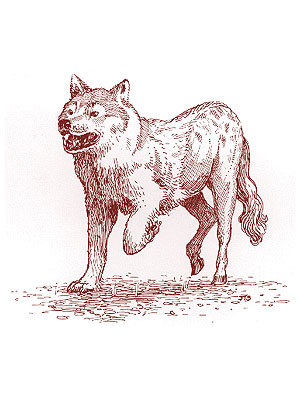
Caniquine
These unusual animals are half canine and half equine, possessing the head and front legs of a large dog and the hindquarters of a horse. Though caniquines possess the strength of horses, their colour and hair length is consistent with the characteristics of large dogs ranging from short, woolly fur to long, smooth hair in colours ranging from white and yellow to the darkest black.
These creatures sometimes serve as work animals, but they are better used as mounts. Because caniquines are intelligent, they are easily tamed and taught. They understand simple verbal commands and can communicate with a variety of barks, growls, and body movements. Even without orders, they will always defend their masters from any apparent hostility. Caniquines are also very playful and respond well to affection.
The Red Curse: About 1 in 10 caniquines suffer from the Red Curse; these few require cinnabryl to ward off Affliction. Of the affected, only those with Legacies valuable enough to counterbalance the cinnabryl expense are kept. The rest are often killed or set free. Fly, Anti-Missile, Leap, Projectile, and War Cry are Legacies considered valuable for caniquines.
Combat: In the wild, caniquines hunt in small packs, usually led by an alpha male. They charge the intended prey, running it down and falling on it with vicious abandon.
When tamed and ridden, a caniquine will use its snapping bite against any threat to its master. If the caniquine has been trained as a combat mount, it will also kick with its back feet, inflicting 2d6 points of damage to a single opponent. In order to both kick and bite in the same round, its master must signal when to kick. Kick attacks can only be implemented when stationary, but the bite attack is easily accomplished even at a hard ride.
Habitat/Society: When hunting in packs, the stronger caniquines feed first, followed by the weak and then the young. They hunt herd animals and any solitary wild creatures. They seldom attack humanoids, and never lupins. On their own, the caniquines tend toward individual family units, usually consisting of a male, a female, and their young.
Caniquines are often bred and raised in captivity. They will serve as loyal mounts to all races except for rakastas and lupins. Rakastan feline behaviour upsets them, and the lupin dislike for caniquines is extremely evident. Lupin legends claim that caniquines were bred by Immortals (or possibly powerful wizards) who desired more intelligent, compliant mounts, but the feliquines turned out to be too prideful for them. Lupins view the animal as an abomination and are disagreeable to any person who owns one.
Ecology:
Caniquines seem to prefer humanoid care and will often wander into a village
looking for food and attention. Very few are wild enough to stay far from
civilisation, and these are left pretty much alone. Feliquines and caniquines
do not get along. Still, because the feliquines are stronger, the caniquine
pretty much leave them alone unless travelling in a pack.
